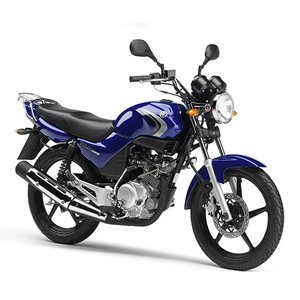Yamaha YBR 125 (2005-2008): A Timeless Entry-Level Champion Revisited
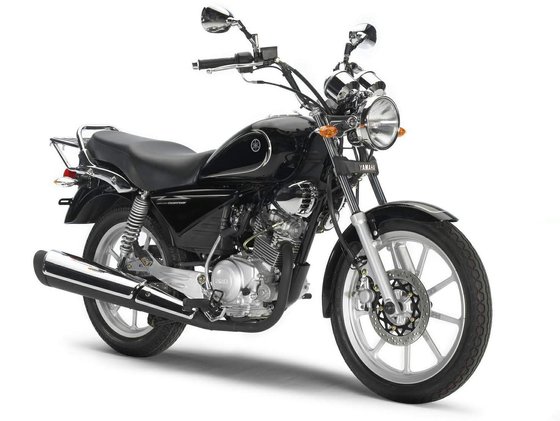
Introduction
The Yamaha YBR 125, produced between 2005 and 2008, remains a cornerstone of the 125cc segment. Designed as an accessible, no-nonsense commuter with occasional flair for style, this motorcycle generation struck a chord with new riders, urban commuters, and even seasoned motorcyclists looking for a reliable secondary bike. With variants like the YBR 125 Custom adding a touch of retro charm, this generation’s legacy lies in its simplicity, durability, and surprising versatility. After spending a week with a well-preserved 2007 YBR 125 Custom, here’s why this motorcycle still deserves attention in the modern era.
Design & Styling: Function Meets Subtle Personality
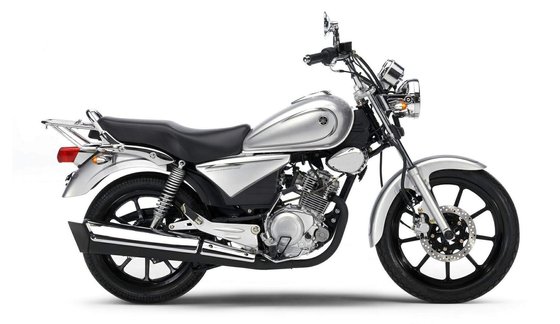
The YBR 125’s design philosophy leans heavily on practicality, but Yamaha injected just enough style to keep it from feeling utilitarian. The base model features a minimalist naked bike profile with a slim fuel tank, straightforward analog instrumentation, and a no-frills seat. However, the YBR 125 Custom (introduced in 2007) elevates the aesthetic with a teardrop-shaped 12-liter fuel tank, valanced fenders, and chrome accents on the exhaust shield, rear carrier, and turn signals. The Custom’s 9-spoke alloy wheels and wide 130mm rear tire add a muscular stance, while its lowered seat height (760mm vs. the standard 780mm) and upright handlebars create a relaxed riding position reminiscent of classic cruisers.
Despite its budget-friendly roots, fit-and-finish details like welded seams, paint quality, and switchgear feel robust—a hallmark of Yamaha’s build standards. The Custom’s dual-tone upholstered seat is surprisingly plush for a 125cc bike, though the standard YBR’s solo seat prioritizes mobility for lane-splitting in traffic.
Engine & Performance: Modest Power, Maximum Efficiency
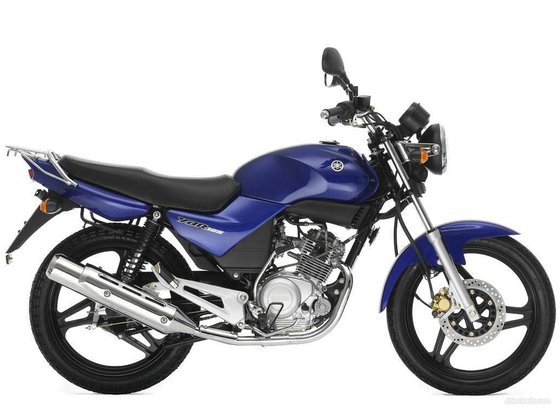
At the heart of the YBR 125 lies an air-cooled, 124cc single-cylinder engine—a design that’s virtually bulletproof. Pre-2007 models use a carbureted setup (Mikuni VM22SH), while 2007–2008 variants transitioned to fuel injection, boosting throttle response and cold-start reliability. Output figures are modest: 10.1 HP at 7,800–10,000 RPM and 9.6–10 Nm of torque peaking around 6,100–8,000 RPM. On paper, this translates to a top speed of 100 km/h (62 mph), but real-world riding sees 85–90 km/h (53–56 mph) as a comfortable cruising ceiling.
Where the YBR shines is fuel efficiency. With a tested consumption of 2.5 L/100 km (94 mpg), the 12-liter tank delivers a 480 km (298 mi) range—perfect for week-long commutes. The engine’s broad torque curve avoids the “all-or-nothing” power delivery of some 125cc rivals, making it forgiving for beginners. The 5-speed gearbox shifts smoothly, though the clutch requires frequent adjustment to maintain its light pull.
Key Takeaways:
- Pre-2007 models: Carbureted simplicity, easier DIY tuning.
- 2007–2008 models: Fuel-injected refinement, better altitude compensation.
- Not a highway star, but a city and backroad maestro.
Handling & Comfort: Lightweight Agility Meets Surprising Poise
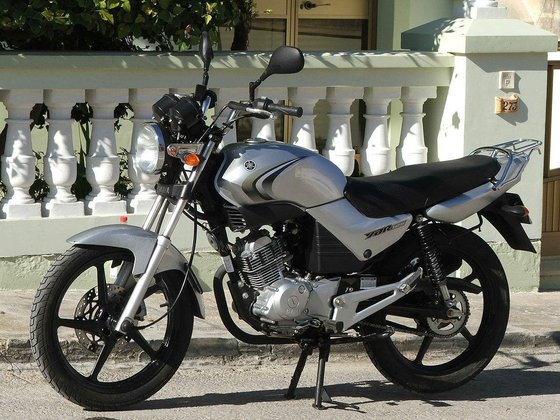
Weighing just 106–113 kg (233–249 lbs) dry, the YBR 125 feels featherlight at low speeds. The steel diamond frame and telescopic forks offer neutral steering, while the rear swingarm absorbs bumps adequately despite its basic shock setup. The Custom’s wider tires enhance stability, but the standard YBR’s 21-inch front wheel (vs. the Custom’s 18-inch) feels slightly more nimble over potholes.
Braking is adequate for the bike’s performance: a front 245mm disc (single-piston caliper) and rear drum provide predictable stopping power, though wet conditions demand caution. Suspension travel is limited (120mm front/105–200mm rear), so rough roads will test your patience. Still, the riding position—upright on the Custom, slightly forward-leaning on the standard model—keeps fatigue at bay during hour-long rides.
Competition: How the YBR 125 Stacks Up
The 125cc segment in the mid-2000s was fiercely competitive. Here’s how the YBR 125 fared against its rivals:
1. Honda CG125
- Pros: Legendary reliability, even simpler mechanics.
- Cons: Dated styling, weaker suspension.
- Verdict: The CG125 is a workhorse, but the YBR offers better aesthetics and a smoother ride.
2. Suzuki GN125
- Pros: Classic cruiser looks, comfortable seat.
- Cons: Heavier (128 kg), less fuel-efficient.
- Verdict: The GN125 appeals to style-focused riders, but the YBR Custom matches its charm with lower running costs.
3. Hero Honda Splendor
- Pros: Unmatched fuel efficiency, ubiquitous parts.
- Cons: Underpowered (8.2 HP), utilitarian design.
- Verdict: The Splendor dominates in frugality, but the YBR is the better all-rounder.
Maintenance: Keeping Your YBR 125 in Prime Shape
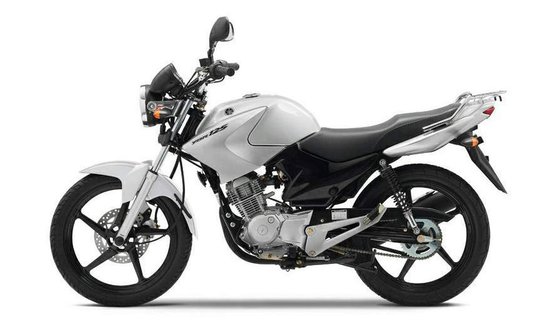
The YBR 125’s maintenance routine is straightforward, but neglect can lead to costly repairs. Here’s what owners should prioritize:
- Valve Adjustments
- Interval: Every 4,000 km (2,485 mi).
- Specs: Intake 0.08–0.12 mm, Exhaust 0.10–0.14 mm (cold).
-
Pro Tip: Use a feeler gauge and torque wrench for precision.
-
Oil Changes
- Interval: Every 3,000 km (1,864 mi).
- Capacity: 1.0L (1.2L with filter).
-
Recommendation: MOTOPARTS.store’s synthetic 10W-40 oil reduces engine buzz.
-
Chain Care
- Adjustment: Every 500 km (311 mi).
-
Lubricant: MOTOPARTS.store’s high-adhesion chain lurk minimizes spray-off.
-
Brake Service
- Fluid: Replace DOT 4 every 2 years.
-
Pads: Upgrade to sintered pads for sharper bite.
-
Tire Pressures
- Front: 1.75 bar (25 psi).
- Rear: 2.0–2.8 bar (29–41 psi).
Conclusion: Why the YBR 125 Still Matters
The Yamaha YBR 125 (2005–2008) isn’t about cutting-edge tech or adrenaline-pumping speed. It’s about mastering the fundamentals: reliability, efficiency, and rider-friendly ergonomics. Whether you’re threading through city traffic on a standard YBR or enjoying weekend jaunts on the Custom, this motorcycle proves that greatness lies in simplicity. For owners looking to personalize their ride, MOTOPARTS.store offers everything from performance air filters to custom seats—ensuring your YBR 125 remains as unique as your riding journey.
Specifications sheet
| Engine | |
|---|---|
| Stroke: | Four-stroke |
| Ignition: | CDI/TCI (model dependent) |
| Max power: | 7 kW | 9.0 hp |
| Max torque: | 10 Nm |
| Fuel system: | Carburettor (pre-2007), Fuel Injection (post-2007) |
| Max power @: | 7800 rpm |
| Displacement: | 124 ccm |
| Max torque @: | 7400 rpm |
| Bore x stroke: | 54.0 x 54.0 mm (2.1 x 2.1 in) |
| Configuration: | Single |
| Cooling system: | Air |
| Compression ratio: | 10.0:1 |
| Number of cylinders: | 1 |
| Dimensions | |
|---|---|
| Wheelbase: | 1290 mm (50.8 in) |
| Dry weight: | 113 |
| Wet weight: | 129 |
| Seat height: | 780 mm (30.7 in) / 760 mm (29.9 in) (Custom model) |
| Overall width: | 745 mm (29.3 in) |
| Overall height: | 1080 mm (42.5 in) |
| Overall length: | 1980 mm (78.0 in) |
| Ground clearance: | 175 mm (6.9 in) (Standard), 140 mm (5.5 in) (Custom) |
| Fuel tank capacity: | 12 L (3.17 US gal) |
| Drivetrain | |
|---|---|
| Final drive: | chain |
| Chain length: | 118 |
| Transmission: | 5-speed |
| Rear sprocket: | 45 |
| Front sprocket: | 14 |
| Maintenance | |
|---|---|
| Rear tire: | 90/90-m18 |
| Engine oil: | 10W40 |
| Front tire: | 90/90-m21 |
| Brake fluid: | DOT 4 |
| Spark plugs: | NGK CR6HSA or NGK CR6HIX |
| Spark plug gap: | 0.7 |
| Forks oil capacity: | 0.31 |
| Engine oil capacity: | 1.2 |
| Engine oil change interval: | Every 5000 km or 2 years |
| Valve clearance (intake, cold): | 0.08–0.12 mm |
| Valve clearance check interval: | 24,000 km (15,000 mi) |
| Valve clearance (exhaust, cold): | 0.10–0.14 mm |
| Recommended tire pressure (rear): | 2.0 bar (29 psi) solo, 2.8 bar (41 psi) with passenger |
| Recommended tire pressure (front): | 1.75 bar (25 psi) |
| Chassis and Suspension | |
|---|---|
| Frame: | Steel double cradle |
| Rear brakes: | Drum |
| Front brakes: | Single 245 mm disc |
| Rear suspension: | Swingarm, 105 mm (4.1 in) travel |
| Front suspension: | Telescopic forks, 120 mm (4.7 in) travel |



